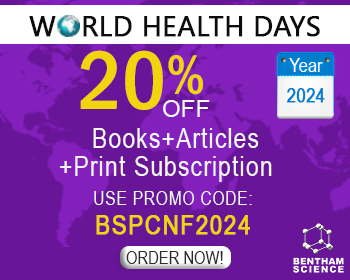[1]
Mitchell P, Liew G, Gopinath B, Wong TY. Age-related macular degeneration. Lancet 2018; 392(10153): 1147-59.
[2]
Wong WL, Su X, Li X, et al. Global prevalence of age-related macular degeneration and disease burden projection for 2020 and 2040: A systematic review and meta-analysis. Lancet Glob Health 2014; 2(2): e106-16.
[3]
Kauppinen A, Paterno JJ, Blasiak J, Salminen A, Kaarniranta K. Inflammation and its role in age-related macular degeneration. Cell Mol Life Sci 2016; 73(9): 1765-86.
[4]
Parmeggiani F, Sorrentino FS, Romano MR, et al. Mechanism of inflammation in age-related macular degeneration: an up-to-date on genetic landmarks. Mediators Inflamm 2013; 2013: 435607.
[5]
Raoul W, Auvynet C, Camelo S, et al. CCL2/CCR2 and CX3CL1/CX3CR1 chemokine axes and their possible involvement in age-related macular degeneration. J Neuroinflammation 2010; 7: 87.
[6]
Falk MK, Singh A, Faber C, Nissen MH, Hviid T, Sorensen TL. CX3CL1/CX3CR1 and CCL2/CCR2 chemokine/ chemokine receptor complex in patients with AMD. PLoS One 2014; 9(12): e112473.
[7]
Combadiere C, Feumi C, Raoul W, et al. CX3CR1-dependent subretinal microglia cell accumulation is associated with cardinal features of age-related macular degeneration. J Clin Invest 2007; 117(10): 2920-8.
[8]
Despriet DD, Bergen AA, Merriam JE, et al. Comprehensive analysis of the candidate genes CCL2, CCR2, and TLR4 in age-related macular degeneration. Invest Ophthalmol Vis Sci 2008; 49(1): 364-71.
[9]
Mattapallil MJ, Wawrousek EF, Chan CC, et al. The Rd8 mutation of the Crb1 gene is present in vendor lines of C57BL/6N mice and embryonic stem cells, and confounds ocular induced mutant phenotypes. Invest Ophthalmol Vis Sci 2012; 53(6): 2921-7.
[10]
Zhang J, Tuo J, Cao X, Shen D, Li W, Chan CC. Early degeneration of photoreceptor synapse in Ccl2/Cx3cr1-deficient mice on Crb1(rd8) background. Synapse 2013; 67(8): 515-31.
[11]
Chen M, Hombrebueno JR, Luo C, et al. Age- and light-dependent development of localised retinal atrophy in CCL2(-/-)CX3CR1(GFP/GFP) mice. PLoS One 2013; 8(4): e61381.
[12]
Imai T, Hieshima K, Haskell C, et al. Identification and molecular characterization of fractalkine receptor CX3CR1, which mediates both leukocyte migration and adhesion. Cell 1997; 91(4): 521-30.
[13]
Ma W, Wong WT. Aging changes in retinal microglia and their relevance to age-related retinal disease. Adv Exp Med Biol 2016; 854: 73-8.
[14]
Shaw AC, Goldstein DR, Montgomery RR. Age-dependent dysregulation of innate immunity. Nat Rev Immunol 2013; 13(12): 875-87.
[15]
Tuo J, Bojanowski CM, Zhou M, et al. Murine ccl2/cx3cr1 deficiency results in retinal lesions mimicking human age-related macular degeneration. Invest Ophthalmol Vis Sci 2007; 48(8): 3827-36.
[16]
Song L. The observation of clinical therapeutic efficacy of ZQMT on non-ischemic retinal vein occlusion. Chin J Clin Rat Drug Use 2014; 7(36): 138-9.
[17]
Jin M, Zhang Y, Pan L, Dou R, Nussenblatt RB, Wei L. The Chinese medicine formula HB01 reduces choroidal neovascularization by regulating the expression of vascular endothelial growth factor. J Transl Med 2012; 10: 118.
[18]
Zhang W, Li Y, Lin J, et al. Comparison of hematoxylin-eosin staining and methyl violet staining for displaying ghost cells. Eye Sci 2013; 28(3): 140-3.
[19]
Ambati J, Fowler BJ. Mechanisms of age-related macular degeneration. Neuron 2012; 75(1): 26-39.
[20]
Ding X, Patel M, Chan CC. Molecular pathology of age-related macular degeneration. Prog Retin Eye Res 2009; 28(1): 1-18.
[21]
Bowes Rickman C, Farsiu S, Toth CA, Klingeborn M. Dry age-related macular degeneration: mechanisms, therapeutic targets, and imaging. Invest Ophthalmol Vis Sci 2013; 54(14): ORSF68-80.
[22]
Prasad PS, Schwartz SD, Hubschman JP. Age-related macular degeneration: current and novel therapies. Maturitas 2010; 66(1): 46-50.
[23]
Leung E, Landa G. Update on current and future novel therapies for dry age-related macular degeneration. Expert Rev Clin Pharmacol 2013; 6(5): 565-79.
[24]
Pieramici DJ, Rabena MD. Anti-VEGF therapy: Comparison of current and future agents. Eye (Lond) 2008; 22(10): 1330-6.
[25]
Hussain RM, Hariprasad SM, Ciulla TA. Treatment burden in neovascular AMD: Visual acuity outcomes are associated with anti-VEGF injection frequency. Ophthalmic Surg Lasers Imaging Retina 2017; 48(10): 780-4.
[26]
Liu Y, Yin HJ, Shi DZ, Chen KJ. Chinese herb and formulas for promoting blood circulation and removing blood stasis and antiplatelet therapies. Evid Based Complement Alternat Med 2012; 2012: 184503.
[27]
Duan L, Xiong X, Hu J, Liu Y, Li J, Wang J. Panax notoginseng saponins for treating coronary artery disease: A functional and mechanistic overview. Front Pharmacol 2017; 8: 702.
[28]
Melo PA, do Nascimento MC, Mors WB, Suarez-Kurtz G. Inhibition of the myotoxic and hemorrhagic activities of crotalid venoms by Eclipta prostrata (Asteraceae) extracts and constituents. Toxicon 1994; 32(5): 595-603.
[29]
Wang S, Cunnusamy K. Pharmaceutical composition for treating macular degeneration (WO2012079419). Expert Opin Ther Pat 2013; 23(2): 269-72.
[30]
Jin M, Dai H, Zhang X, et al. A traditional chinese patent medicine ZQMT for neovascular age- related macular degeneration: A multicenter randomized clinical trial. Curr Mol Med 2018; 18(9): 622-9.
[31]
Luhmann UF, Lange CA, Robbie S, et al. Differential modulation of retinal degeneration by Ccl2 and Cx3cr1 chemokine signalling. PLoS One 2012; 7(4): e35551.
[32]
Ambati J, Anand A, Fernandez S, et al. An animal model of age-related macular degeneration in senescent Ccl-2- or Ccr-2-deficient mice. Nat Med 2003; 9(11): 1390-7.



























